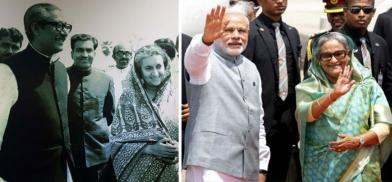India-Bangladesh ties: A role model for neighbouring countries
India and Bangladesh can show the world how neighbouring countries can become all-weather friends, writes Jubeda Chowdhury for South Asia Monitor

Bangladesh-India bilateral relations are a role model in the world in terms of relations among neighboring countries. They are deep and have evolved over time. India is seen as Bangladesh’s true friend.
On December 6, 1971, India granted diplomatic recognition to Bangladesh as an independent and sovereign country. The same day, Bhutan recognized Bangladesh. India has stood by Bangladesh since the Liberation War started. It provided shelter and food to one crore refugees, training and arms to the freedom fighters and all assistance to the Bangladesh government-in-exile. After India's recognition, Pakistan was quickly defeated in a joint offensive by the Mukti Bahini, the Bengali independence militia, and Indian forces on December 16. The date is very important for Bangladesh.
This relationship has expanded in many different ways in a spirit of friendship, understanding and mutual respect. Under the visionary leaderships of Prime Ministers Narendra Modi of India and Sheikh Hasina of Bangladesh, the two countries have become partners in a "shonali adhyaya" (golden chapter).
Bangladesh celebrates the birth centenary of the Father of the Nation, Sheikh Mujibur Rahman, and 50 years of independence. This year is also the 50th year of Bangladesh-India diplomatic relations. On December 6, for the first time, Bangladesh and India celebrated ‘Friendship Day’ in 16 countries.
Foundation of ties
Sheikh Mujibur Rahman and Indira Gandhi laid the foundation of bilateral relations through a 25-year Friendship Treaty in 1972, which his daughter, Sheikh Hasina has consolidated and diversified. Bangladesh has become an important partner of India due to its 'Neighbours first' policy.
After the Treaty of Friendship, a trade agreement was signed in 1973 and the Mujib-Indira border agreement in 1974. After Mujibur Rahman’s assassination in 1975, social, political, economic and commercial relations between Bangladesh and India deteriorated. After 21 years, when the Awami League came to power, an atmosphere of trust and expectation was created again.
This led to the historic Ganges water agreement. After Sheikh Hasina returned to power in 2009, bilateral relations again improved. Since Modi took power in 2014, the two Prime Ministers have taken relations to a new height. The seven-year-old enclave exchange, maritime demarcation and other unresolved issues began to be resolved.
Sheikh Hasina has reiterated her commitment to further strengthen the mutual ties. The anniversary has given us an opportunity, she said, to think about the basis of the bilateral relations and the way forward. Now it is necessary to focus on connectivity, trade, business and communications among the people.
In a tweet on Friendship Day, Modi said: “Together we are remembering and celebrating 50 years of friendship. I look forward to continuing to work with … Sheikh Hasina to broaden and deepen our ties.”
A year-long programme has been chalked out to celebrate the 50th anniversary of diplomatic relations. Bangabandhu-Bapu digital exhibitions are being held in different cities of the two countries. The two leaders unveiled stamps commemorating Bangladesh-India friendship. Exchange of visits of veterans of war, inspection of ships, sports events, and cultural and other programmes are being organized.
Milestone year
This year will be significant for Bangladesh and India. Modi visited Dhaka on March 26-27. Indian President Ram Nath Kovind will decorate the closing ceremony of Victory Day. Sheikh Hasina may be the Chief Guest on India’s Republic Day.
Revolutionary changes have been made in the communication system of the two countries to make the economy dynamic. Dhaka, Kolkata and Khulna-Kolkata passenger train services and rail services for transporting goods from Chilhati in Nilphamari to Haldibari and Dhaka-Siliguri in West Bengal and Dhaka-Kolkata, Dhaka-Agartala, Dhaka-Siliguri-Darjeeling bus services have been introduced. In March, the Prime Ministers inaugurated the Sabroom Bridge over the Feni river, which connects Ramgarh in Khagrachari to Tripura. With the 1.9 km bridge, new business doors have been opened.
Under the Protocol on Inland Water Transit and Trade (PIWTT) agreement, there are plans to connect the Sonamuri-Daudkandi route of the Gumti river and the waterway from Dhulia-Godagari to Aricha on the Padma. Cargo transportation activities have been started from Chittagong port to Tripura. But some pending issues such as the Teesta water-sharing issue and killings on the border should be resolved as soon as possible.
India will provide training and technical assistance to Bangladesh through military experts. India was the first country to provide free vaccines to Bangladesh to battle Covid-19. Amid a shortage, an Oxygen Express entered Bangladesh with 180 tonnes of oxygen.
Sheikh Mujibur Rahman had said on February 8, 1972 in Calcutta: “India-Bangladesh friendship will remain intact forever. No power in the world can separate it. Occasionally some anti-independence, fundamentalist forces try to destroy the relations between the two countries. But their efforts will not succeed. Because the basis of Bangladesh-India friendly relations is trust and confidence. This relationship is written in the blood through the great liberation war.”
India and Bangladesh can show the world how neighbouring countries can become all-weather friends.
(The author has a Masters degree in International Relations from the University of Dhaka. The views expressed are personal. She can be contacted at jubedachowdhury103@gmail.com)
can write or else it is difficult to write.
internet. You actually understand how to bring a prolem to light and mwke it important.
Alot more people really need to look at this and understand this side of your story.
I was surprised that you aren't more popular since you
certainly possess the gift.









Post a Comment